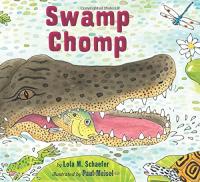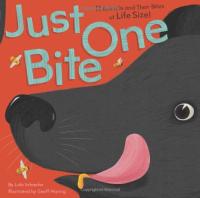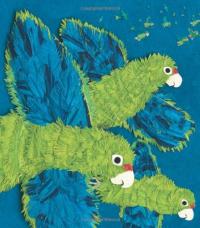
As swamp residents move, water ripples and the creatures munch, gulp, swallow, and more. Short, rhythmic sentences and simple but realistic illustrations present a wetlands food chain. A brief endnote describes the environment and “balance of nature.” The language in this informational picture book reads well aloud, likely to engage listeners.
Swamp Chomp

A dot of “dirt (and everything in it)” is a meal for the earthworm seen in a stylized, double page illustration. Four pages open with gatefolds to show the giant squid which is the sperm whale’s feast. Actual sizes of what animals eat are dramatically presented with additional information on the last spread.
Just One Bite: 11 Animals and Their Bites at Life Size!

Sharp eyes are needed to see most of the well-camouflaged creatures in the Costa Rican rainforest presented in stunning, realistic illustrations. A simple, repeated sentence lets emerging readers know what (e.g., bird, snake) to look for in each double page spread. The animals are specifically identified on the final page.
Can You See Me?

As a young, sickly child, “Teedie” Roosevelt dreamed of becoming an adventurer like in the books he gobbled up. Lush, expressive illustrations, well-chosen quotes, and a lucid text brings the life of the boy who grew into a remarkable man whose biggest adventure may have been that of the 26th President of the United States.
To Dare Mighty Things

Sophisticated readers will appreciate the snippets of presidential history presented in a variety of poetic forms. Illustrations, reminiscent of political cartoons, range in tone from serious to silly. Additional information about the office and the individual presidents concludes this appealing and surprisingly informative collection (which includes the sitting POTUS).
Rutherford B., Who Was He? Poems About Our Presidents

The friendship between Lafayette and Washington is dramatically told for sophisticated readers in a handsome picture book format. It began while the fledgling United States fought for its independence from Britain though it continued after the war. Additional information about the two men and the time in which they lived is included.
Revolutionary Friends: General George Washington and the Marquis de Lafayette

Privyet! Welcome to Russia! Come along on this ABC exploration of the people, geography, animals, plants, history, and culture of Russia. Read about diamond studded eggs, the deepest lake in the world, and other fascinating facts.
Russia ABCs: A Book About the People and Places of Russia

An overview of what’s involved in putting on and participating in the Olympics. Learn about the opening ceremonies, the many Olympic events in the Summer and Winter games, the medal presentations, and the Olympic village.
Olympics

Stravinsky, a composer, and a dancer named Nijnsky each worked alone until they met. Their collaboration initially surprised Parisians but has become a classic. Meet the composer and choreographer who created “The Rite of Spring” in evocative, swirling text and image.
When Stravinsky Met Nijinsky

What does any letter of the alphabet represent? Can you find the “embrace” in the letter E? Graphic artist Thurbly shows the action or the object created from each upper case letter from A to Z. The result is sure to inspire young artists to create while building vocabulary.
Paul Thurbly’s Alphabet

Dots abound in lots of colors all around, everywhere and every day. Some are heavy, others are light; some are even edible. This color-filled, playful, cheery look at everyday things in which dots are seen is sure to inspire creative examinations of the world around.
Lots of Dots

A group of young men from Liverpool changed the world of music and they enjoyed a good laugh — often on themselves. The Fab Four and their humor are presented in appealing stylized illustrations and a lighthearted narrative well suited to the material presented.
The Beatles Were Fab (and They Were Funny)

What sound does an excavator or a forklift make? Each makes its own noise, presented here in bold, dramatic typefaces dynamically shown on sturdy horizontal pages. Children can be encouraged to repeat sounds made by the variety of equipment — likely to delight construction aficionados.
Diggers Go

Discover why boats — even filled with people — can float, but a small pebble sinks in water. Easy experiments and lucid explanations are presented with cartoon-like illustrations to bring concepts like density and displacement into focus for readers of all ages.
Things That Float and Things That Don’t

Is the magic in the book or with the reader as they are asked to tap the brown tree? A green leaf appears and then when rubbed, pink blossoms emerge. A rhythmic text encourages participation to see seasonal changes in the sturdy tree from winter’s end to spring birds nesting.
Tap the Magic Tree

There are faces all around. They can be seen in everyday things, like a chair. And they can be made from fruits and vegetables, tools and what is found in the garden. When imaginations are let loose, there are all kinds of faces to see and to make! Cheerful collages made from different materials are sure to inspire creativity and making faces.
Let’s Make Faces

Katherine Olivia Sessions grew up in Northern California’s woods where she did things that most other 19th century girls didn’t do: get dirty, study science and complete college. Kate grew up to become known as “Mother of [San Diego’s] Balboa Park.” Stylized illustrations and text present this unique woman and her scientific accomplishments.
The Tree Lady

How colorful parrots that have lived on the island of Puerto Rico for “millions of years” almost disappeared but can again be seen today makes an exciting saga. Enjoy the richly colored collage cutouts illustrate alone or read the informative text which details the history of parrots and their island home.
Parrots Over Puerto Rico

All animal babies are appealing. It’s hard to avoid an “awe” or two when dipping into this collection of factoids and photographs that present lots of babies of all types. The taste of information is sure to inspire readers to find out more about the furred, feathered and even cold-blooded babies.
101 Animal Babies

Homan Walsh wanted to win the prize for flying his kite, Union, from one side the Niagara River to the other — the first step in building a bridge connecting Canada and the U.S. Stylized paintings and simple text tell a powerful story (based in fact) of persistence and hope.
The Kite that Bridged Two Nations

Ruth Elder was a beauty queen but in 1927 she showed her pluck when she and a copilot took off for Paris. Though she didn’t make it that time, she continued to demonstrate that women were fine pilots and could fly solo. Ruth’s early life and aviation is fascinatingly revealed through evocative narration and illustration.
Flying Solo: How Ruth Elder Soared into America’s Heart

A partial image of an animal is accompanied by the question, “What am I?” With a turn of the page, a larger look at the animal is shown, accompanied by “Where am I?” Another turn reveals the habitat. Handsome, highly realistic watercolors in a predictable format introduce animals, ending with a portrait of a boy “on the beautiful Earth.”
What Am I? Where Am I?

How big were the dinosaurs really? Though a deadly hunter, the microraptor “would barely be able to look a modern-day chicken in the eye.” Energetic illustrations contrast dinosaurs to things familiar and contemporary. Add animated text for a memorable look at size and prehistoric creatures.
How Big Were Dinosaurs?

From swamps to coral reefs, animals use camouflage. Lush, realistic, double page illustrations ask readers to find a particular number of animals in each habitat. With the turn of the page, the habitat is described and all animals are identified.
